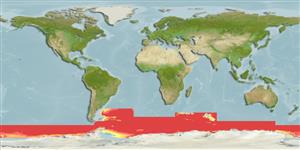>
Myctophiformes (Lanternfishes) >
Myctophidae (Lanternfishes) > Gymnoscopelinae
Etymology: Gymnoscopelus: Greek, gymnos = naked + Greek, skopelos, a lantern fish (Ref. 45335).
Environment: milieu / climate zone / profondeur / distribution range
Écologie
marin bathypélagique; océanodrome (Ref. 51243); profondeur 550 - 900 m (Ref. 58018). Deep-water; 40°S - 75°S
Circumpolar south of Antarctic Polar Front, but absent from the southern and central regions of Ross and Weddell seas and extending to 40°S in Falkland Current region.
Taille / Poids / Âge
Maturité: Lm ? range ? - ? cm
Max length : 16.2 cm SL mâle / non sexé; (Ref. 5182)
Épines dorsales (Total) : 0; Rayons mous dorsaux (Total) : 15 - 18; Épines anales: 0; Rayons mous anaux: 16 - 18.
Oceanic and bathypelagic (Ref. 4066). Adults found usually deeper than 500 m, but larvae and juveniles in 66 to 200 m at temperatures of -0.18°C to 6.23°C.
Life cycle and mating behavior
Maturité | Reproduction | Frai | Œufs | Fécondité | Larves
Hulley, P.A., 1990. Myctophidae. p. 146-178. In O. Gon and P.C. Heemstra (eds.) Fishes of the Southern Ocean. J.L.B. Smith Institute of Ichthyology, Grahamstown, South Africa. (Ref. 5182)
Statut dans la liste rouge de l'IUCN (Ref. 130435: Version 2025-1)
Menace pour l'homme
Harmless
Utilisations par l'homme
Outils
Articles particuliers
Télécharger en XML
Sources Internet
Estimates based on models
Preferred temperature (Réf.
123201): -0.2 - 1, mean 0.5 °C (based on 72 cells).
Phylogenetic diversity index (Réf.
82804): PD
50 = 0.5039 [Uniqueness, from 0.5 = low to 2.0 = high].
Bayesian length-weight: a=0.00437 (0.00200 - 0.00953), b=3.16 (2.96 - 3.36), in cm total length, based on LWR estimates for this (Sub)family-body shape (Ref.
93245).
Niveau trophique (Réf.
69278): 3.3 ±0.40 se; based on food items.
Résilience (Réf.
120179): Milieu, temps minimum de doublement de population : 1,4 à 4,4 années (Preliminary K or Fecundity.).
Fishing Vulnerability (Ref.
59153): Low vulnerability (10 of 100).
🛈
